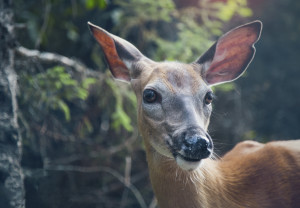 The great American garden writer, Elizabeth Lawrence, famously said, “No one gardens alone.” The truth of those words shows in my garden every day. Ninety percent of the landscape and tending falls to me; the rest is done by others. Fortunately, given the state of my bank accounts, I don’t have to pay them anything. They are enthusiastic—sometimes over-enthusiastic–volunteers.
The great American garden writer, Elizabeth Lawrence, famously said, “No one gardens alone.” The truth of those words shows in my garden every day. Ninety percent of the landscape and tending falls to me; the rest is done by others. Fortunately, given the state of my bank accounts, I don’t have to pay them anything. They are enthusiastic—sometimes over-enthusiastic–volunteers.
The largest of the “others” is the well-known Mr. Antlers and his crew of mostly female hangers-on. Their collective specialty is pruning. They have pruned all my asters, especially the taller ones, for years. Fortunately the asters appreciate this pruning, branch out as the result of it and eventually produce more blooms than unpruned plants. I have never known the deer to prune the plants while they are in bloom. Maybe the flowers taste awful, or possibly the Antlers clan likes the look of asters. Who knows?
The deer also prune my roses, nipping off the tender flower buds and new growth, while avoiding the thorny older canes. This does not cause the kind of positive branching that the asters produce, but the roses eventually bloom—as long as I apply deer repellant to them after the deers’ initial pruning efforts.
The miracle of regrowth does not happen with statuesque Oriental and Asiatic lilies, which are among the favorites of the Antlers clan. Once the buds are nipped off, the plants will wait an entire year before producing new ones. It is extremely frustrating to see the stalks standing tall and proud and know that there is no hope of blooms. The same is true of hostas, which the deer often nibble almost down to the ground. The beautiful broad leaves that make hostas a go-to plant for shady areas will not reappear until late spring next year.
Groundhogs are also ace pruners, but due to their low, rotund profile, they focus on plants close to the ground. One year I decided to install a number of large, ornamental cabbages in the back gardens to liven things up after Labor Day. The groundhogs took the idea of livening things up seriously and apparently had a party with cabbage as the main course. Two days after I bought and installed the cabbages, they had been eaten down to ground level. I can only hope that all that cabbage had a dramatic effect on the groundhogs’ digestion.
Squirrels do not prune, they plant. This generally happens when spring flowering bulbs, especially small ones, are planted in the fall. As every suburbanite knows, squirrels like to bury their acorns, chestnuts and other food treasures. In the course of doing so they sometimes unearth bulbs. I suspect that they treat the bulbs just like acorns and rebury them in a different spot. In typical squirrel fashion, they never remember where anything is buried, so the stolen bulbs sprout in the squirrel-selected sites. I have a large stand of Crocus tommasianus in the back garden and every spring I find stray “tommie” crocuses blooming several feet, or sometimes several yards from the original clump. Once I found one in the front yard. Generally I just lift and replant the squirrel-sown bulbs. Occasionally the squirrels install bulbs in interesting places. When that kind of landscaping effort happens, I leave it alone.
The plants themselves are sometimes the best landscapers. Most hardy geraniums distribute seeds by projecting them as much as three feet from the mother plant. The germination rate for these seeds is high, which means an abundance of new geraniums. My garden is the cottage type, so many of the self-sown plants stay where the seeds land. The surplus seedlings go elsewhere in the garden, creating desirable repetition in the planting scheme. Good self seeders include larkspur, nigella, morning glory, dame’s rocket, columbine and rose campion. If you have morning glory growing up a trellis, let it set seed in the fall. I guarantee that you will never have to buy a fresh package of morning glory seeds and, in fact, you will have morning glories everywhere, because they are prodigious self-seeders.
Growing an abundance of self-seeding plants can result in a beautiful, lush landscape that mimics growth patterns seen in the wild. Also, since the seedlings are the result of open pollination, you may end up with plants that bloom in slightly different colors than the parent. This can create a very artistic effect. Of course, if you like a little more discipline in the landscape, you can reposition the seedlings so they will appear as well controlled as the rest of your garden.
When I am in the garden I never fail to hear the voices of the plants, whispering about history, folklore and adaptation. They also complain about the weather. In the midst of that, I swear that I also hear rustling noises just on the other side of the fence. I am convinced that the rustling comes from my volunteer landscapers, who are waiting impatiently to begin their work.
